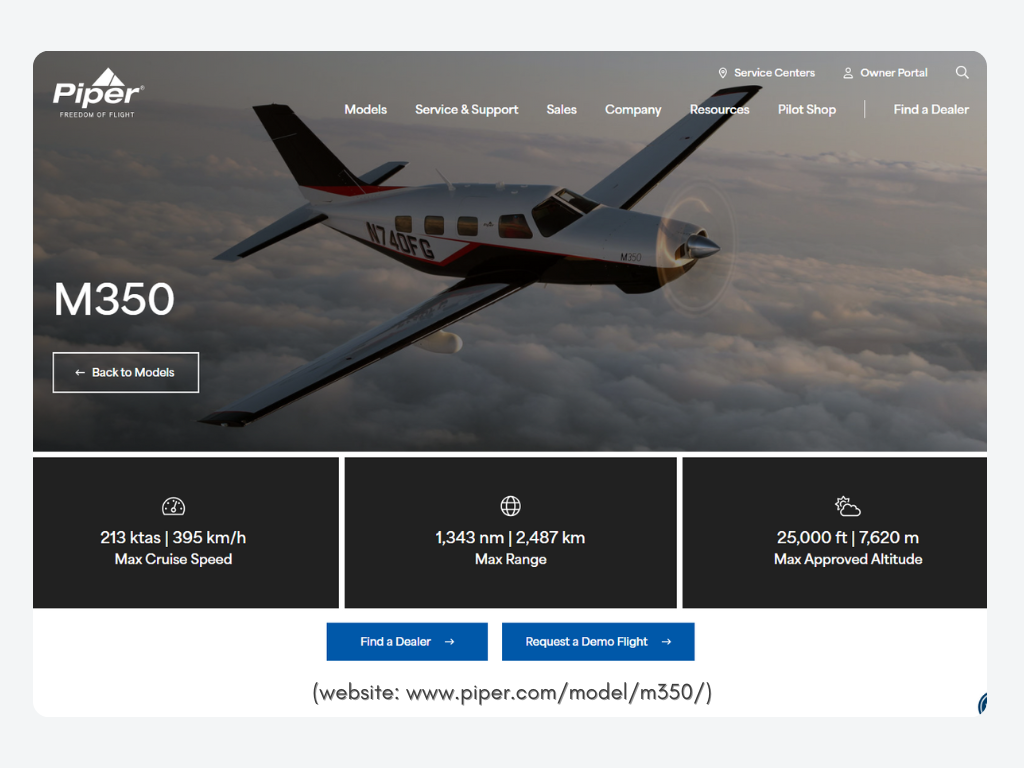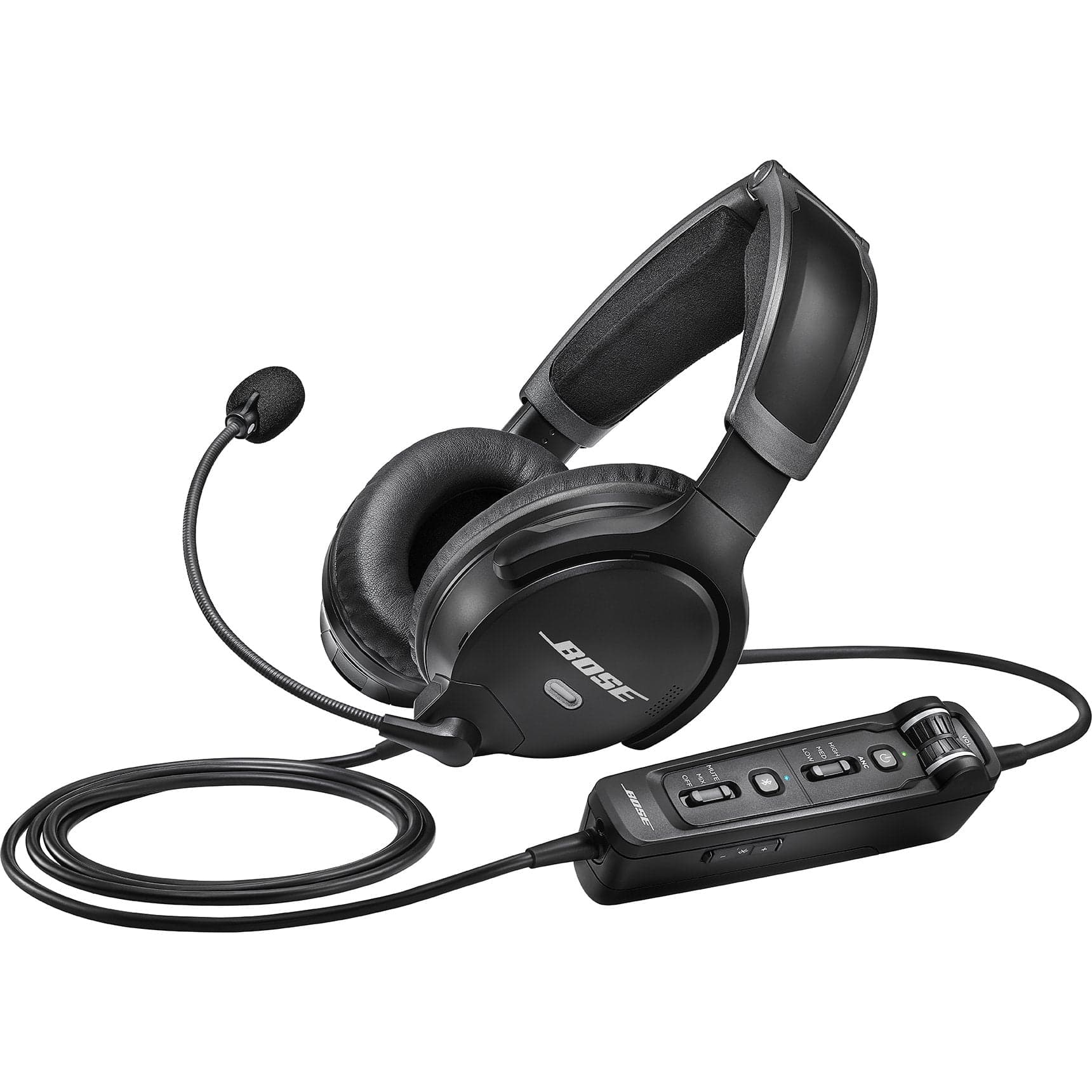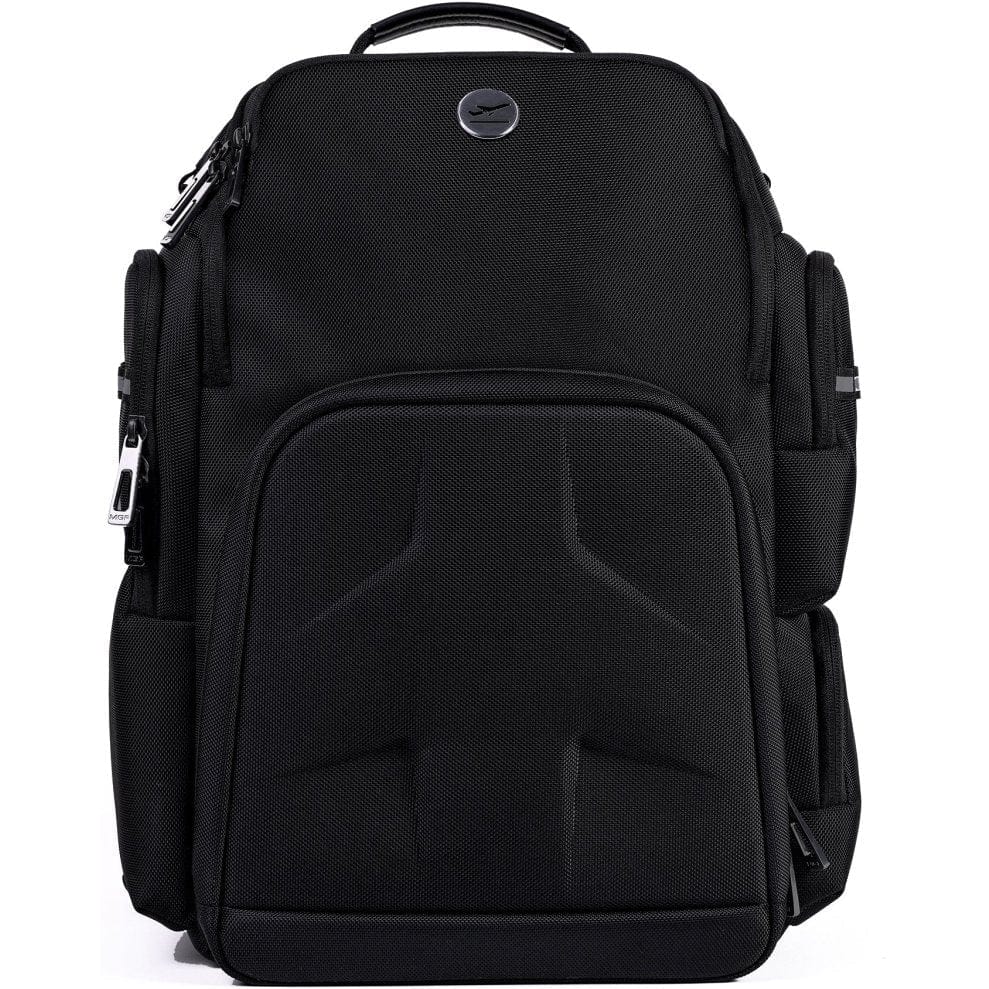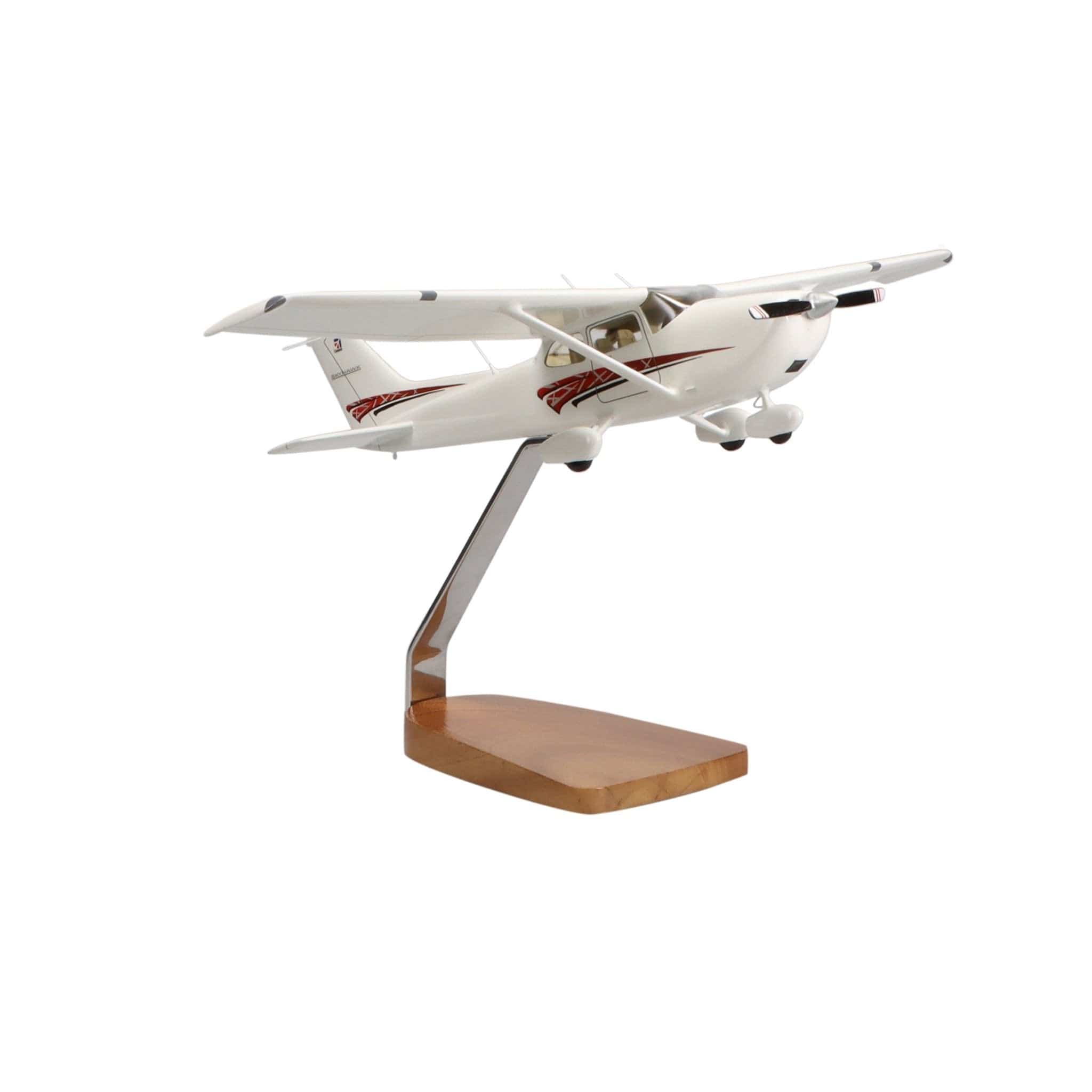What do you do if you want to fly your private plane in the flight levels in comfort without wearing an oxygen mask or dealing with air tubing in the cabin? Do you need to make the move and master the learning curve of twin engines or is there a solid single engine pressurized option?
Meet the Piper M350.
The Piper M350 is a currently in production low-wing single-engine turbocharged piston light jet aircraft with retractable landing gear. It’s a descendant of the very successful Malibu Mirage and part of the Piper PA-46 family of aircraft that are well-known in the pressurized cabin single engine light jet market.
Keep reading to learn more about the features that make this plane and its family members so successful, plus what it’s like to fly the 350, and of course all the specs to help you decide if a Piper M350 should be the next plane on your aircraft buying shortlist.
We’ll start with some backstory.
History of Single-Engine Pressurized Cabin Planes
The Piper PA-46 was the third pressurized cabin single-engine piston aircraft on the market, following the Mooney M22 Mustang and the Cessna P210 Centurion.
Mooney’s offering was first flown in 1964 and received type certification in 1966 but sales were poor, and each plane was sold at a loss. The Cessna P210 Centurion debuted in 1978. It achieved better success than the Mooney, but still not as good as the Piper PA-46 which entered the market in 1983.
Of these three pioneering aircraft, the PA-46 is the only one still in production today.
(By John Davies - CYOW Airport Watch - Gallery page, Image, GFDL 1.2, Wikipedia link)
Designing the Piper PA-46
Development work for the Piper PA-46 started in the late 1970s. The prototype, designated the PA-46-300T, was designed using computer aided design and manufacturing technology (CAD/CAM). This reduced the necessary assembly time for the PA-46 planes and helped to improve their profitability.
The prototype PA-46 was test flown in November 1979 and the new PA-46 type was officially announced in November 1982, with certification and production following in the fall of 1983.
Although the original prototype version was unpressurized, cabin pressurization was one of the biggest selling features for the Malibu (the first production plane in the PA-46 line).
Piper PA-46 Variants
From the time the original PA-46 went into production in 1983 until today, Piper has continued to make updates and design tweaks. The PA-46 variants all share a common original design that has evolved over time. Here’s how it all began:
PA-46-310P Malibu
The first PA-46 variant was the 310P Malibu. Deliveries of the Piper Malibu started in November 1983. This first variant set multiple world speed records, but its 310 hp Continental TSIO-520-BE engine was discontinued in 1988 after multiple documented cases of engine failures causing accidents and incidents.
(By Alec Wilson from Solihull, United Kingdom - HS-POT, CC BY-SA 2.0, Wikipedia link)
PA-46-350P Malibu Mirage
After the Continental engine issue in the 310P, the new 350P was given a more powerful 350 hp Lycoming TIO-540-AE2A engine. The wing design was also revamped for the 350P.
After 1988, the 350P Mirage went through several additional updates including a move to glass windshield in 1995, overhead console switches in 1996, and a more robust wing design (brought over from the Meridian) in 1999.
PA-46R-350T Matrix
Although the PA-46 line is known for its pressurized cabins, the 350T Matrix is an exception. The Matrix is basically an unpressurized version of the Mirage and is marketed as a step-up from the Cessna 400 and Cirrus SR-22. Although the Matrix isn’t pressurized, it does come outfitted with an on-board oxygen generation system (OBOGS).
(By Alan Lebeda - Gallery page, Image File, GFDL 1.2, Wikipedia link )
PA-46-500TP Malibu Meridian
Given the lasting success of the Mirage, in 1997 Piper announced its turboprop sibling the Malibu Meridian. This design was based on the Mirage but included larger wings and tail surfaces to support the turboprop power. The Meridian’s cockpit got a makeover in 2009 with a three-screen Garmin G1000 complete with GFC 700 autopilot.
Piper M-350
In 2015, Piper revamped their premium aircraft models and introduced a fresh naming convention, turning the PA-46 line into the Piper M-Line. After its makeover, the Malibu Mirage re-emerged as the M350. (We will do a deep dive on the M-350’s upgraded features in the next section).
Piper M-500
During the M-Class revamp, the Meridian was given the designation M500. Design additions include the Garmin G1000 NXi system and ADS-B. The flaps are larger, and the wing, horizontal tail, and firewall-forward section were also all re-designed.
PA-46 M600
The M600 is the latest addition to the Piper M-Class lineup. The M600 design is an upgraded version of the M500 with more horsepower, greater fuel capacity (which translates to extended range), and a higher top speed.
One of the most exciting features of the M600 is the inclusion of a Garmin emergency autoland system called HALO Safety System. Once engaged automatically or by someone onboard (such as a non-pilot passenger), HALO can monitor and take control of the aircraft, configure for landing, land, and shut down the engine.
(By Bidgee, CC BY-SA 3.0 au, Wikipedia link)
Distinctive Features of the Piper PA-46 M350
What stands out about the modern Piper M350 compared to other aircraft? Here’s a rundown of the M350’s key design features and capabilities:
Pressurized Cabin
Let’s start with the headlining selling point of the M350 (and indeed most of the PA-46 line): the cabin pressurization system. The bleed air pressurization lets you fly at the maximum service altitude of 25,000 feet while maintaining a cabin pressure altitude of just 8,000 feet.
Airstair
First impressions are important, and Piper sets the stage for luxurious comfort by nailing the ramp appeal aspect of the M350 design. As they cross the tarmac, your passengers are greeted by a welcoming airstair door that opens into the well-appointed and comfortable cabin.
Electronic Stability Protection (ESP)
All three models in the Piper M-Class are loaded with next level safety features in the form of the Electronic Stability Protection (ESP) system which is integrated into the Garmin G1000 NXi avionics package (more on that next).
ESP is a flight envelope protection system that functions independently of the autopilot. It monitors the aircraft’s flight condition to recognize and correct for any loss-of-control scenarios.
If pitch or roll deviations exceed maximum recommended limits, the ESP system will apply the appropriate control force(s) to return the plane to stable flight. Underspeed and overspeed conditions like stalls and too-steep descents are also recognized and corrected early with the ESP.
If the ESP system remains active for a designated period of time, the autopilot system will engage. This is meant to aid in situations where the pilot is incapacitated.
Advanced Avionics
The current M350 design is outfitted with an upgraded Garmin G1000 NXi avionics suite.
The newer system includes:
- Three high-resolution cockpit screens.
- Increased processing power.
- SurfaceWatch runway identification.
- Flight Stream 510 Connext wireless cockpit connectivity.
- Enhanced approach and landing assistance with go-around procedures.
- WAAS GPS-based guidance used to seamlessly transition from enroute to terminal area flight
- Automated takeoff procedures.
- Hypoxia Recognition System with Automatic Descent Mode to pitch aircraft down and safely return to a lower altitude if the autopilot is engaged and the pressurization system fails. This feature helps prevent a hypoxia-induced loss of control accident.
Pulse Oximeter
Speaking of pilot hypoxia, you can certainly purchase your own stand-alone pulse oximeter to monitor your oxygen levels. When you fly the Piper M350, however, this tool is already built in.
Simply place your finger in the panel-mounted oximeter and your oxygen levels and heart rate will display on your Garmin screen. Watch the M350s pulse oximeter in action for a better idea of how it works.
(Image from Piper's M350 Brochure)
Flying a Piper M350
The experience of flying the M350 begins with the undeniable ramp appeal and continues as you settle into the cockpit to appreciate the triple screen Garmin interface. If you’re flying during the hot summer months, the onboard air conditioning will be another clear bonus.
When configuring for takeoff, engage the go-around button. Yes, it’s meant for ensuring a smooth aircraft recovery and response to autopilot-flown missed approaches, but the go-around feature on the M350 also has practical applications during takeoff.
With the go-around engaged, once you’re airborne (at a rotation speed of 75 to 80 knots), the M350 will automatically transition to a seven-degree pitch-up attitude climb angle.
After system startup, you can disable Garmin’s Electronic Stability Protection (ESP) system if you want, but if left enabled, the ESP will help keep the M350 safely within its flight envelope throughout the flight. It does so by providing control inputs to counter potentially problematic speeds, attitudes, etc.
For example, if you approach stall speed with the ESP on, the underspeed protection (USP) safety system will take control and lower the nose of the plane.
Likewise, if the plane is rolled into a bank angle that steepens beyond 45 degrees, the servos will apply stronger and stronger aileron counter pressure. If the steep bank isn’t corrected, the autopilot will engage and return the plane to a wings level configuration.

Pro Tip: If you find yourself in an unsafe or loss of control situation, simply pressing the “LVL” button instructs the ESP to take over and restore the plane to a wings level configuration with zero vertical airspeed.
(source: Piper)
Purchasing a Piper M350
The average list price for a pre-owned Piper M350 is currently around $1,300,000. The most recently published base price for a new Piper M350 with standard equipment (no upgrade packages) was $1,195,000 in 2020.
According to Aircraft Cost Calculator, assuming 450 flight hours per year and a fuel cost of $7.25 per gallon, M350 owners should plan for a yearly variable cost of $149,850.

Pro Tip: Before you commit to buying a PA-46, reach out to other owners to get a better feel for the maintenance budget you will need. If there’s one gripe that PA-46 owners have, it is with the frequency and cost of maintenance.
Another point to consider is insurance. The PA-46 Series aircraft can be more challenging to insure if you are a lower hour pilot. Get quotes in advance to confirm you’ll be covered and to price out your options.
Piper M350 Specifications
- Engine: Turbocharged Lycoming TIO-540-AE2A
- Horsepower: 350 hp
- Propeller: Hartzell 3-blade composite constant speed
- Length: 28.9 feet
- Height: 11.3 feet
- Wingspan: 43 feet
- Cabin Length: 12.25 feet
- Cabin Width: 4.08 feet
- Cabin Height: 3.9 feet
- Seats: 6
- Standard Empty Weight: 3,050 pounds
- Maximum Takeoff Weight: 4,340 pounds
- Maximum Ramp Weight: 4,358 pounds
- Maximum Landing Weight: 4,123 pounds
- Standard Useful Load: 1,308 pounds
- Fuel Capacity: 120 usable gallons
- Payload With Full Fuel: 588 pounds
- Internal Baggage: 20.0 cu ft
- External Baggage: 13.0 cu ft
Piper M350 Performance
- Takeoff Distance Ground Roll: 1,087 feet
- Takeoff Over 50 ft. Obstacle: 2,090 feet
- Max Cruise Speed: 213 ktas
- Max Range with 45-min. reserve: 1,343 nautical miles
- Service Ceiling: 25,000 feet
- Landing Distance Ground Roll: 1,020 feet
- Landing Over 50 ft. Obstacle: 1,968 feet
- Max Cabin Differential Pressure: 5.5 psid
Frequently Asked Questions
- What sets the Piper M350 apart from other aircraft?
The M350 boasts a pressurized cabin system, advanced avionics with Garmin G1000 NXi suite, Electronic Stability Protection (ESP), and a built-in pulse oximeter, offering exceptional safety and comfort.
- How does the cabin pressurization system work in the Piper M350?
The bleed air pressurization system enables flying at 25,000 feet with a cabin pressure altitude of just 8,000 feet, reducing the effects of high altitudes and enhancing passenger comfort.
- How is flying the Piper M350 unique?
Flying the M350 offers an impressive experience, including an automatic transition to a climb angle after takeoff, advanced autopilot, and ESP system assistance, ensuring stability and safety during flight.
- How fast can a Piper M350 fly?
The Piper M350 has a maximum cruise speed of 213 knots (ktas).
- What is the cruise speed of the M350 long range?
The M350's long-range cruise speed is not specified in the provided information.
- Is the Piper M350 pressurized?
Yes, the Piper M350 features a pressurized cabin system that allows flying at high altitudes while maintaining a comfortable cabin pressure.
- How much does the M350 cost per hour?
According to the Aircraft Cost Calculator: Based on 450 annual owner-operated hours and $6.75-per-gallon fuel cost, the PIPER M350 has total variable costs of $143,550.00, total fixed costs of $93,780.00, and an annual budget of $237,330.00. This breaks down to $527.40 per hour.
It’s Your Turn
Have you owned or flown a Piper M350 or one of the other Piper PA-46 or Piper M-Series aircraft? We’d like to hear from you!
Which M-Series or original PA-46 variant is your favorite and why? Any design or handling aspects you would change? Have you needed to up your maintenance budget compared to other aircraft you’ve owned? What should potential new owners look for as they shop for a Piper M-Series plane?
Considering Buying a Plane? These Reads are for You:
- Affordable Personal Aircraft to Fit Your Budget (2020 Guide)
- Easiest Planes to Fly for Anyone (With a Pilot License)
- 10 Fastest Single-Engine Planes Today
- 7 Best Single Pilot Jets Available in 2020
Want to learn about flight maneuvers?
Our guides are designed to help student pilots become professional pilots and for private pilots to brush up on their knowledge and skills.
Did you find this article helpful?
Do you think we missed anything important? Let us know in the comments below!














